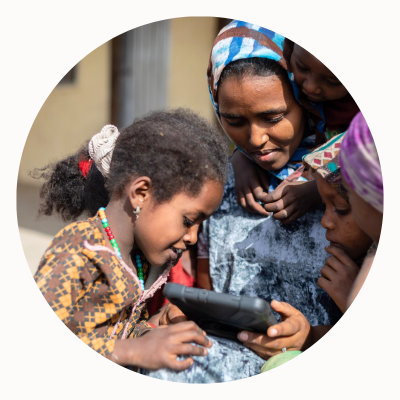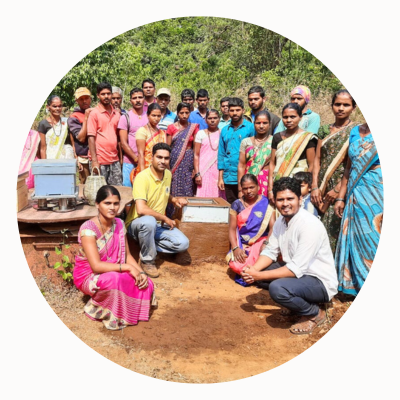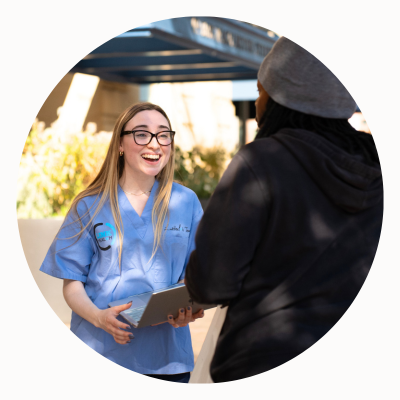AI for all: Lessons from the intersection of technology and inclusion
January 7, 2025 | By Vicki Hyman
From extending credit to Colombian micro-entrepreneurs to reducing maternal morbidity rates in Ethiopia to delivering lifesaving information to refugees around the world, the power of artificial intelligence is being matched with the potential for inclusion and economic empowerment.
Redefining how to use AI for social impact, five organizations will develop and scale their solutions as winners of the Artificial Intelligence to Accelerate Inclusion Challenge, which received more than 500 submissions across 82 countries. The winners — which also include a social enterprise for small-scale beekeepers in India and a U.S. initiative that connects patients with underutilized federal benefits — will receive $200,000 and technical assistance and mentorship with Mastercard and data.org, which sponsored the challenge.
The Mastercard Newsroom spoke to leaders from the winning organizations about the challenges of building AI solutions in the social sector, how they’re mitigating bias and training their models to be inclusive, and what other sectors hold the most promise for the technology.
Bridging the funding gap for small businesses in Colombia: Quipu
 In Colombia, nearly 6 million businesses are microenterprises, operating with fewer than 10 employees and a small amount of capital. Of those, only 9 percent can borrow formally, due to lack of information about their performance and absence of financial history, and this creates an enormous funding gap.
In Colombia, nearly 6 million businesses are microenterprises, operating with fewer than 10 employees and a small amount of capital. Of those, only 9 percent can borrow formally, due to lack of information about their performance and absence of financial history, and this creates an enormous funding gap.
Quipu bridges the information gap in the informal economy by using AI to more accurately assess the creditworthiness of these smaller enterprises through a scoring model that analyzes nontraditional data, such as mobile transaction histories, social media interactions, SMS and payment patterns, and intelligent disbursement and credit collection. It also provides a financing platform and microloans that allow these businesses to build an alternative credit score based on both financial and nonfinancial information. Through Quipu’s app, customers can apply in minutes for working capital that is disbursed in less than two days.
Bolstering community health care in Ethiopia: IDinsight
 Two decades ago, Ethiopia launched a new model for rural health care, training and deploying thousands of health extension workers to serve local communities, which has resulted in significant improvements in maternal and child health, and declines in new HIV infections and tuberculosis- and malaria-related deaths, to name a few.
Two decades ago, Ethiopia launched a new model for rural health care, training and deploying thousands of health extension workers to serve local communities, which has resulted in significant improvements in maternal and child health, and declines in new HIV infections and tuberculosis- and malaria-related deaths, to name a few.
To build on that success, IDinsight is partnering with Last Mile Health and Ethiopia’s Ministry of Health on an AI-powered call center that the health extension workers can contact for real-time medical guidance on complex cases. The organization’s AI solution will include a case management system and a question-answering service based on comprehensive Ministry of Health guidelines, providing real-time support to call center agents who will further relay critical information to the health care workers via phone, allowing them to focus on patient care and delivering high-quality health care.
Delivering life-saving information to people in crisis around the world: International Rescue Committee’s Signpost Project
 A record 120 million people are displaced worldwide by conflict, natural disaster, poverty and violence. People impacted by crisis must make critical, life-changing decisions throughout their journey to safety with limited information. In 2015, the International Rescue Committee launched the Signpost Project, which establishes digital help centers for users to find accurate and timely information, access critical services and ask direct questions to local moderators, such as, How can I access housing? Will I be able to get a temporary work permit? Can I enroll my children in school?. Signpost has nearly 30 active programs worldwide, with over 6 million Signpost users in 2024.
A record 120 million people are displaced worldwide by conflict, natural disaster, poverty and violence. People impacted by crisis must make critical, life-changing decisions throughout their journey to safety with limited information. In 2015, the International Rescue Committee launched the Signpost Project, which establishes digital help centers for users to find accurate and timely information, access critical services and ask direct questions to local moderators, such as, How can I access housing? Will I be able to get a temporary work permit? Can I enroll my children in school?. Signpost has nearly 30 active programs worldwide, with over 6 million Signpost users in 2024.
However, information needs increase alongside the number of displaced people. During the 2023 crisis in Afghanistan, one Facebook post resulted in 30,000 messages within one month, overwhelming the local Signpost team of six moderators. In 2024, the IRC-led Signpost Project launched Signpost AI to enhance the delivery of critical information through AI agents and human oversight. This system aims to reduce the burden on moderators, enabling them to focus on more complex cases, while ensuring timely and accurate responses that improve access to resources and services for displaced populations globally.
Building a hive of knowledge for beekeepers in India: Buzzworthy Ventures

India remains a global agricultural dynamo, but one agricultural value chain lacks buzz: beekeeping. There are 400,000 small-scale beekeepers in India, many of whom struggle to sustain livelihoods, let alone enhance the economic potential of insect pollination for improving crop yields. In India, insect pollination contributes $22.52 billion a year, far exceeding the market size of honey and hive products, yet the potential remains vastly underutilized for crops essential to India’s economy and nutrition.
So Buzzworthy Ventures created Beekind, an AI-driven mobile application to empower small-scale beekeepers, particularly women, small landholders, landless farmers and tribal populations in rural and marginalized communities. It provides real-time insights and predictive analytics, helping beekeepers manage their hive health, diagnoses diseases, improve honey production and adapt to changing climate conditions.
Closing the health-wealth gap in the U.S.: Link Health
 Emergency physician Alister Martin often saw that poverty was the driving factor behind patients’ visits to the emergency department. He realized that “money as medicine”—helping patients access cash assistance and federal benefits — could address the root causes of poor health by closing the health-wealth gap.
Emergency physician Alister Martin often saw that poverty was the driving factor behind patients’ visits to the emergency department. He realized that “money as medicine”—helping patients access cash assistance and federal benefits — could address the root causes of poor health by closing the health-wealth gap.
This led to the creation of Link Health, a program that connects patients with unspent federal aid programs like SNAP, WIC and Lifeline to ease the financial strain that exacerbates health disparities. The AI-enabled enrollment platform and chatbot aims to unlock $10 million in state and federal benefits to alleviate poverty, reduce financial stress and improve well-being.
What was the biggest challenge in getting your solution off the ground?
Mercedes Bidart, CEO and co-founder, Quipu
“The biggest challenge was to secure the first amount of capital to start lending to train our scores. Creating a new underwriting solution is like the chicken-and-egg problem: You need capital to build the solution, but you don’t get it until you tested it.”
Sid Ravinutula, chief data scientist, IDinsight
“The first challenge is technical. In a health care context, treatments and recommendations must be 100% accurate — there is no room for hallucinations. This requires a different approach than the popular retrieval-augmented generation architecture. We need to construct a graph that accurately captures treatments and diagnostic protocols.
“The second challenge is creating representative benchmarks and validation sets. Before iterating and improving the model, we need a dataset of questions and answers that these workers are likely to ask. This dataset must encompass all the topics they may inquire about and account for how they might ask — using shorthand, colloquial terms, emojis, etc. Building a high-quality benchmark dataset is expensive, as it often requires human annotation.”

André Heller, program manager, Signpost
“One of the biggest challenges has been developing AI tools that are both inclusive and contextually accurate. Training AI to understand minority languages, regional dialects and culturally nuanced content requires extensive data curation, human expertise and testing. Additionally, ensuring that AI-generated responses uphold humanitarian principles and do not perpetuate bias has required building robust safeguards, such as human-in-the-loop oversight and constitutional rewrites for ethical output. Balancing innovation with these rigorous standards has been demanding but essential.”

Monika Shukla, CEO and co-founder, Buzzworthy Ventures
“The primary challenge lay in bridging the gap between advanced AI technology and its adoption in grassroots, rural settings. While internet connectivity in India has grown exponentially — with over 700 million internet users in 2023, driven largely by affordable smartphones — access remains uneven. This digital divide, coupled with patchy network coverage in remote forests and villages, posed a significant obstacle to deploying AI-driven solutions that require consistent connectivity and user interaction.”

Alister Martin, CEO, Link Health
“Navigating and accessing public benefits can be a hurdle for many families. However, the biggest challenge was integrating Link Health’s intervention seamlessly into health care settings where providers are already overwhelmed. This required building trust among health care workers, ensuring that navigators didn’t disrupt patient care while showing measurable benefits to patients and healthcare systems.”
How do you ensure your solution is both bespoke and inclusive?
Mercedes Bidart, Quipu: “To mitigate bias, we use diverse datasets, regularly audit our AI models and apply human-in-the-loop validation to ensure fair and equitable credit assessments. Our algorithms are rigorously tested to prevent gender and racial bias, and we continuously monitor and update them to align with ethical standards. We also provide users with accessible redress processes, allowing them to challenge or appeal AI decisions.”
Sid Ravinutula, IDinsight: “First, we are building this as an open-source solution. We hope this will accelerate the deployment of similar tools in other contexts by allowing organizations to build upon it for their specific needs. Second, we are ensuring it can be easily customized and extended for local contexts. This includes adhering to local guidelines, switching AI models or adding new guardrails. By creating a common model that can be fine-tuned for each context, we ensure the solution is widely applicable while respecting the unique requirements of each setting.”
André Heller, Signpost: “Signpost AI is trained using curated, verified data from trusted sources and local NGOs. This ensures the AI reflects regional dialects, cultural norms and minority languages, filling critical gaps for underserved populations. AI agents support voice and text inputs, enabling accessibility for people with low literacy. Tools are tested and refined with native speakers and community moderators to validate accuracy and inclusivity. Our AI Constitution democratically establishes ethical rules, including nondiscrimination and trauma-sensitive language, with ongoing audits to mitigate bias.”
Monika Shukla, Buzzworthy Ventures: “Beekind tailors its tech-and-touch solutions to specific regional, ecological and crop conditions, integrating hyperlocal factors such as climate, flora and farming practices. To achieve this, we actively involve local beekeepers, researchers, agricultural experts and community leaders in codesigning practices, models and implementation strategies, ensuring that the solution aligns with the lived realities of the people it serves. We prioritize women and smallholder farmers — key yet underserved contributors to India’s agricultural ecosystem. For instance, by providing gender-sensitive training and creating inclusive spaces for dialogue, we empower women to actively participate in and benefit from the beekeeping value chain. Inclusivity is not just a principle; it is a practical cornerstone of our approach.”
Alister Martin, Link Health: ”Navigators meet patients where they are — physically and emotionally — often in waiting rooms, and tailor their approach to specific patient needs, such as enrolling older adults in benefits like Medicare Savings Programs. By designing systems that prioritize accessibility and use trusted community messengers, the program ensures it serves diverse populations effectively, especially underserved communities.”
What is the biggest concern you have around AI?
Mercedes Bidart, Quipu: “The most important piece when building AI models is the dataset. A good model is one that has a good and fair outcome, and the only way of making that possible is training models with diverse datasets that represent the particularities of each region. The other important piece of the puzzle is the person/team that builds the model. Just 20% of AI jobs are done by women, which means the outcomes are not being reviewed from a gender lens. We need more women leading AI solutions.”
Sid Ravinutula, IDinsight: “Reliability. In health care, an incorrect diagnosis or incomplete treatment can have catastrophic consequences. However, AI models inherently exhibit randomness. For instance, asking an AI the same question multiple times may yield slightly different responses. Similarly, rephrasing a question can produce varying answers. While most responses will likely convey the same message, some may be incomplete or misleading, potentially causing harm. Strong guardrails are essential to ensure all responses are correct, complete and respectful.”
André Heller, Signpost: “The biggest concern is AI’s potential to cause harm through bias, misinformation or exclusion. For vulnerable populations, incorrect information can have life-altering consequences. Ensuring AI is contextually accurate, transparent and ethical requires constant oversight, testing and collaboration with local experts. We address this by implementing human-in-the-loop oversight for quality control, bias audits and ethical reviews to refine responses, and transparent frameworks like the AI Constitution, which governs outputs and mitigates harmful risks. We remain vigilant in balancing AI innovation with accountability and trust.”
Monika Shukla, Buzzworthy Ventures: “When AI models are trained using data that isn’t fully representative of the communities they aim to serve, there is a risk of reinforcing existing inequalities. For instance, many AI systems are trained using data in major languages, leaving local dialects and oral languages underrepresented. In India, numerous tribal and regional communities speak languages that often lack robust digital datasets. This lack of representation can lead to models that fail to accurately interpret or respond to the needs of these communities. Additionally, regional accents, speech patterns and lived practices are often overlooked, making AI solutions less effective or even harmful for these groups.”
Alister Martin, Link Health: “The biggest concern is the potential for AI systems to perpetuate existing biases, particularly when working with underserved populations. Without careful oversight, algorithms might inadvertently exclude those most in need or fail to account for the systemic inequities they face. Ensuring transparency, accountability and ethical use of AI in decision-making is critical to avoid exacerbating disparities. This is also why we keep humans in the loop at critical junctures in the process — and why we will continue to keep humans in the loop as we evolve our AI tools.”
What sector outside your own has the potential to benefit the most from AI?
Mercedes Bidart, Quipu: “The educational sector. I believe education has changed and we have the opportunity of making it more democratic. What we have done in Quipu around education is a gen AI assistant on WhatsApp that supports our clients with their business management. There’s no need to have one consultant per business. With one bot we can support the education and growth of millions.”
Sid Ravinutula, IDinsight: “IDinsight is sector-agnostic. While this project focuses on health, we have developed AI solutions in education and social protection. Farmers face similar barriers to information as community health workers. They need to know the best crops to grow for their region and optimal fertilizer mixes, and assistance with diagnosing crop diseases and treatments. In education, AI use cases include personalized tutors, AI-generated lesson plans and AI-powered assessments and evaluations. We’ve used AI to identify out-of-school girls in India for an NGO working to increase girls’ enrollment in schools. Finally, AI can help citizens access government benefits. It can assist in identifying eligibility and navigating the complex application process.”
André Heller, Signpost: “With advances in AI, it’s hard to think of a sector that won’t be transformed. The question is when — two years or five? From business operations to data analysis to diagnostics in health care to research in virtually any field, everything will advance at a pace we’ve not yet seen. It’s just a question of when people will be able to make effective use of it. A practical example: linkage between meteorology and disaster management. Weather alerts and disaster early warning systems, such as floods, hurricanes, droughts and extreme weather events, hold immense potential to benefit from AI. Advanced AI models can analyze real-time meteorological and hydrological data to forecast disasters more accurately and provide early warnings to a more holistic response that includes vulnerable people, local businesses, supply chains and government. Signpost has already begun leveraging AI for flood response through FloodHub, combining AI predictions with actionable, real-time updates to help communities prepare for and mitigate the impact of floods.”
Monika Shukla, Buzzworthy Ventures: “The health care sector stands to benefit significantly from AI, particularly in diagnostics, personalized medicine and optimizing health care supply chains, especially in rural areas. AI-powered tools can assist with the early detection of diseases like malaria and tuberculosis through medical images or diagnostic tests. For instance, AI models can analyze chest X-rays or blood samples to detect early signs of disease, even in low-resource settings. This can lead to faster diagnoses and treatments, ultimately saving lives and reducing health care costs in underserved regions. AI can also streamline logistics in remote health care systems, ensuring timely delivery of medical supplies and vaccines to underserved areas, which is crucial for countries with large rural populations.”
Alister Martin, Link Health: “Education stands to benefit greatly from AI, particularly in personalizing learning experiences for underserved students. AI can help identify gaps in learning, provide tailored support and offer multilingual resources to students and families in ways that traditional models cannot. By addressing inequities in access to quality education, AI could have a transformative impact on future health and socioeconomic outcomes.”

